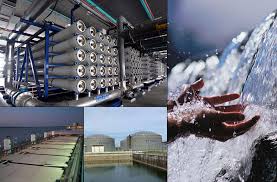The Four National Taps
All living things need water to live.
We can survive without food but not without water. In the early days,
Singapore obtained its water supply from local catchment (dependent on
weather) and imported water from Malaysia. In order to ensure a
sustainable source of water supply to cater to the country’s continued
growth, our national water agency, Public Utilities Board (PUB), has
since built a resilient supply of water from four different sources
known.
What are the four National Taps?
1) Water from local catchment
2) Imported water from Johor
3) Desalinated water from the sea
4)
Reclaimed/Recycled water from local waste water (NEWater)
Water from local catchment
Local catchment water is a pillar of our sustainable water supply.
About two-thirds of Singapore’s land surface comes under a water
catchment system, with more than 14 reservoirs as well as an extensive
network of canals, rivers, drains, storm-water and collection ponds to
harvest rainwater. Singapore is one of the few countries to harvest
storm-water on a large-scale for its water supply.
Marina
Barrage creates Singapore’s fifteenth reservoir, the Marina Reservoir,
further boost Singapore’s water supply. In 2011, Marina Reservoir
together with Punggol and Serangoon Reservoirs, which are our 16th and
17th reservoirs, increased Singapore’s water catchment from half to
two-thirds of Singapore’s land surface.
In the long run, PUB aims to boost Singapore’s water catchment area to 90% by 2060 with variable salinity plant.
Imported water from Johor
Singapore has been importing water from Johor, Malaysia. Both
countries have signed four agreements to regulate the water supply of
water from Malaysian to Singapore.
The first agreement signed on
5th December 1927 between the municipal commissioners of the town of
Singapore and Sultan Ibrahim of the state and territories of Johor, is
no longer in force..
The second agreement were signed on 2nd
October 1961 but effective on 1st September 1961. It was called the
Tebrau and Scudai Rivers Water Agreement and was made between the city
council of state of Singapore and the government of the state of Johor.
It gave Singapore the exclusive right to obtain all the water within
designated land of Gunong Pulai, Sungei Tebrau and Sungei Scudai for a
period of 50 years. It expired in August 2011.
The third
agreement was signed on 29th September 1962 between the Singpore city
council and the Johor state government. It was called the Johor River
Water Agreement. It is valid for 99 years till 2061. It gives Singapore
the exclusive right to draw off water from Johor River.
The
1990 agreement was signed on 24th November 1990 between PUB of Singapore
and the Johor state government. It is supplementary to the 1962
agreement and will expire in 2061. In this agreement, Singapore are
allowed to build a dam across Sungei Linggui to facilitate the drawing
of water from Johor River

Desalinated Water from the sea
Singapore has one of Asia’s largest seawater reverse-osmosis plant to
meet about 10% of Singapore’s water needs. The second plant will be
completed in 2013. As Singapore is an island, desalinated water is an
infinite resource and is readily available. Desalinated water is a
technology-based water source. In September 2005, after years of
research on desalination technologies, Singapore opened the SingSpring
Desalination Plant in Tuas, PUB first public-private partnership (PPP)
project. PUB plans to increase desalination capacity by 2060 so that
desalinated water will be able to meet at least 30% of demand for water
in the long term. It can also further enhance our water supply in an
extended dry spell, e.g. in February 2010. However, its energy
consumption is high.
Reclaimed/Recycled water from local waste water (NEWater)
NEWater is Singapore success story and the key pillar of Singapore
water sustainability. It is high-grade recycled water produced from
treated used water by undergoing a rigorous four-stage process –
conventional water treatment, microfiltration, reverse osmosis and
ultra-violet disinfection. It was first introduced in Singapore in 2002.
It is supplied mainly for non-potable industrial and commercial
uses. NEWater is also of high-grade quality and reliability, making it
also safe for drinking. It has surpassed the World Health Organisation
(WHO) requirements and undergone more than 65,000 scientific tests.
PUB awarded Sembcorp the contract for the fifth and largest NEWater
plant. In 2011, the plant which is located in Changi was completed. This
plant together with the expansion of the existing four NEWater plants
can meet 30% of the nation’s water needs. Used water that is discharged
from homes and buildings is collected in underground pipes to ensure it
is separated from the rainwater from local catchment areas so as to
prevent contamination of the rainwater. Since 2009, The Deep Tunnel
Sewerage System, a 48-kilometer-long superhighway which is connected to
an intricate network of link sewers, transports used water in the
northern and eastern parts of Singapore to Changi Water Reclamation
Plant for treatment before the treated used water is further purified.
Singapore plans, by 2060, the NEWater can meet 50% of our future water demand

